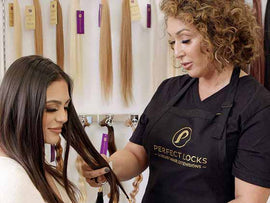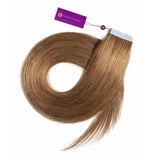Hair extensions are a popular and effective way to enhance natural hair, providing volume and length for a glamorous look. While the installation process is crucial, the real challenge often arises after clients leave the salon and must care for their extensions at home.
In this guide, we will take a closer look into common issues that clients may inadvertently create for themselves post-installation and emphasize the importance of communication to set proper expectations. Ensuring clients understand the do's and don'ts is paramount for maintaining the integrity of their extensions.
1. Misuse of Extensions
Hair extensions, though they are resilient, are not immune to damage. Clients may unknowingly misuse their extensions, leading to preventable issues. Among the common problems is excessive tugging and pulling during brushing or styling, which can stress the bonds and result in premature damage. Educating clients on the fragility of extensions is essential.
Heat styling is another area where clients often make mistakes. Excessive use of hot styling tools without the application of heat protectants can cause irreparable harm to both natural hair and extensions. Clients need to be educated on the significance of using thermal protection products to maintain the health of their extensions.
Solution
As a hairstylist, you should take the time to thoroughly educate clients on proper extension care during the initial consultation and after installation. Emphasizing the importance of gentle handling, using wide-tooth combs, and avoiding excessive heat is crucial. Provide a list of recommended products, including heat protectants, to empower clients to maintain their extensions effectively.
2. Doing Damaging Practices at Home
Clients may engage in damaging practices at home unknowingly, resulting in issues with their extensions. Sleeping with damp hair, especially if it's tangled, can lead to matting and breakage. Furthermore, some clients may attempt DIY coloring or use harsh chemicals on their extensions, compromising their quality.
Solution
Hairstylists must stress the importance of allowing extensions to dry completely before bedtime to prevent matting. Discourage clients from experimenting with chemical treatments at home and provide a list of salon-approved products for any desired color changes.
3. Inadequate Hair Care Routine
Maintaining hair extensions requires a specific care routine, and clients who neglect this may face issues. Infrequent washing can lead to oil buildup, causing discomfort and reducing the lifespan of the extensions. Additionally, using the wrong type of shampoo, conditioner, or styling products can have detrimental effects on both natural hair and extensions.
Solution
Hairstylists should create a personalized care routine for each client based on their hair type and lifestyle. Stress the importance of regular washing using sulfate-free products and avoiding ingredients that may damage extensions.
4. Ignoring Professional Advice
Even with the best intentions, clients may disregard the advice given by their stylists. This can result in various issues, such as skipping maintenance appointments, leading to tangling, matting, and a decrease in overall extension quality. Improper removal of extensions is another concern, potentially causing damage and discomfort.
Solution
Hairstylists should stress the importance of follow-up appointments and adherence to removal guidelines. Providing clear instructions on how clients can maintain their extensions between visits and educating them about potential issues is crucial for long-term satisfaction.
5. Not Setting Proper Expectations and Guarantees
To reduce post-installation problems, hairstylists must establish clear expectations and guarantees during the initial consultation. Thorough consultations should delve into the client's lifestyle, preferences, and expectations to tailor the extension service accordingly.
Solution
Communication is key. As their stylist, you should engage in open and honest discussions with clients, setting realistic expectations for the care and maintenance of extensions. Document the agreed-upon terms and ensure that clients have access to written guidelines for reference.
6. Not Considering Environmental Factors
Clients often forget that environmental factors can impact the longevity of their extensions. Exposure to harsh sunlight, chlorine in swimming pools, and saltwater at the beach can all contribute to premature wear and tear.
Solution
As their hairstylist, you should educate clients on the potential hazards of environmental exposure. Advise the use of protective measures, such as wearing a hat in the sun or tying up hair when swimming, to preserve the quality of the extensions.
7. Not Doing Regular Check-ins
Establishing a routine for clients to check in with their stylist between appointments is crucial. This allows for the early detection of any issues, ensuring prompt intervention and maintenance.
Solution
Encourage clients to schedule regular check-ins, even if it's a brief virtual consultation. This proactive approach allows stylists to address any emerging concerns, offer guidance, and ensure that clients are following the recommended care practices.
8. Not Going Through Seasonal Adjustments
The changing seasons bring different challenges for hair care. Educate clients on the impact of climate changes on their extensions, such as increased humidity or dryness, and provide tips for adjusting their care routine accordingly.
Solution
Offer seasonal tips, like using anti-humidity products during the summer and adding extra moisture in the winter. This helps clients adapt their hair care practices to the specific challenges presented by different seasons.
9. Not Practicing Hair Maintenance During Exercise
Engaging in physical activities can pose challenges for individuals with hair extensions. Sweat, friction, and tying hair tightly can contribute to issues like matting and tangling.
Solution
Provide guidelines on how to care for extensions during workouts. Encourage clients to tie their hair loosely, use sweatbands, and cleanse the scalp and extensions promptly post-exercise to prevent potential problems.
10. Being Prepared for Unexpected Situations
Clients may encounter unexpected situations that can impact their extensions. Creating a small emergency kit with essentials like a gentle detangler, hair ties, and a mini brush allows clients to address minor issues promptly.
Solution
Recommend assembling a small kit for on-the-go care. This proactive measure ensures that clients have the tools needed to handle unforeseen challenges and maintain the quality of their extensions, even when away from home.
Effective post-installation troubleshooting for hair extensions involves proactive communication, education, and ongoing support. By addressing potential issues before they arise and empowering clients with knowledge, hairdressers can contribute to a successful and satisfying hair extension experience. Thorough consultations, clear guidelines, and personalized care contribute to maintaining the health and beauty of hair extensions for the long term.




















